End-Game Vision for The Citadel
March 1, 2023 · 10 minute read
While our Whitepaper and Yellowpaper describe the launch version of The Citadel in great detail, this paper zooms out and takes a high level view of the greater vision we as the Core Team are aligned around. Upon launching the game, we will release ultimate control of the project to the community, and as such we feel it’s important to paint a picture of the North star of The Citadel as we conceive of it.
Much of the foundation of this vision will be in place from day one, while other components are still in the planning stages and will be built by the Core Team and the community in real time as we experiment and iterate together. Over time, we intend for this to be a living document that becomes a reflection of the greater community’s shared vision.
Autonomous World
The Citadel we envision is a living and breathing persistent world created for and by its players on top of an open, modular core platform.
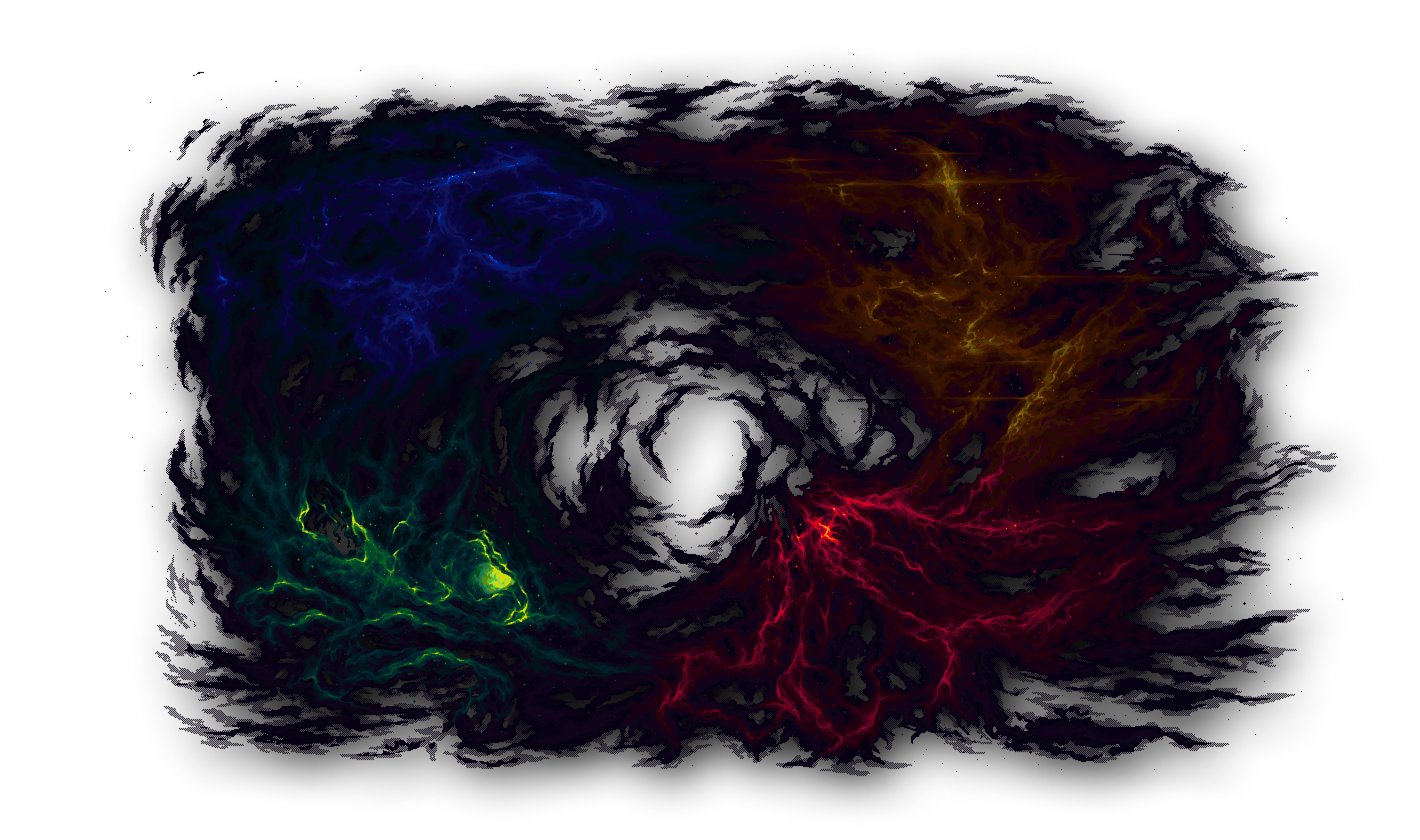
A World On the Blockchain
For all of the constraints that building The Citadel fully onchain imposes, it also unlocks many new possibilities that are native to the blockchain. The reality is that creativity overtook computation as the greatest bottleneck to creating fun and compelling interactive experiences a long time ago. Innovation in gaming has stagnated considerably over the past decade despite breathtaking advances in performance and bandwidth. For many gamers, unlocking genuinely new types of mechanics and experiences will more than make up for reduced throughput – and the throughput is rapidly improving thanks to an explosion of innovation in L2/L3 solutions.
We believe that among the most compelling use cases for blockchains in gaming is a new type of persistent world that exists entirely onchain. Some of the more interesting unlocks include:
- Root level community ownership, enabling meaningful decentralization, autonomy, and self-governance
- Hard physics: onchain game logic and state enables provably fair and credibly neutral rules that all human and non-human agents must follow
- Native composability and interoperability of the blockchain and open token standards
- Opportunities for trustless and permissionless community co-creation of the platform
- Ownership of assets that is meaningful because the world is as durable as the tokens and ownership extends to the context the assets exist in
- Robust token economies built on top of the intrinsic value of virtual assets
- Antifragile persistence – the potential for everlasting games and worlds
A World Forever
Unlike the persistent worlds that have come before it, building onchain means that for the first time we can conceive of building a world that could last indefinitely. If we are to think in terms of decades instead of years for the potential lifespan of a virtual realm, we should also think about how such a long-term project might be sustained. While we can build the technical foundations on the hard digital bedrock the blockchain provides, we must also craft a social and governance framework that can protect the interests of the world's digital residents and wisely steward the project and its resources for all current and future participants.
A World That Matters
Virtual worlds to date have mostly been designed as entertainment products – as toy worlds. But anyone that has spent much time in these spaces knows they were never “just a game”. They are populated with real people, who share real experiences together that can be as meaningful as any other form of social interaction. In spite of their toy-like origins, virtual worlds have always mattered to those that have inhabited them. We want to explore what it would mean to treat these worlds as if they were as significant as we always found them to be. Building a world on the blockchain means elevating virtual worlds from toys to a new medium for human experience.
An Open World
In our personal experiences, the most powerful narratives in online worlds have always come from the dramatic and unpredictable interactions of thousands of real people. By contrast, static or linear experiences pre-ordained by the game developers tend to feel out of touch and less relevant to the player’s actual everyday experiences. The most evergreen user-generated content is simply the presence of other real people in an immersive shared environment.
We want to see players write their own stories. The world should respond dynamically to player’s choices, deeds, achievements, and failures. History, world building, topography, culture, politics, governance, and the economy should all be shaped by players to some meaningful degree.
At the same time, ideally this creative freedom is channeled towards creating a coherent and compelling world. The challenge with sandbox worlds is that starting with a blank canvas can result in space that feels empty, cold, ugly, and pointless. Divergent co-creation can scatter to the winds without a clear North star to align around or convergent waypoints to correct course when too far adrift. We want to cultivate a rich, cohesive environment with a clear sense of purpose for new players to engage with.
A World of Conflict, Built Collaboratively
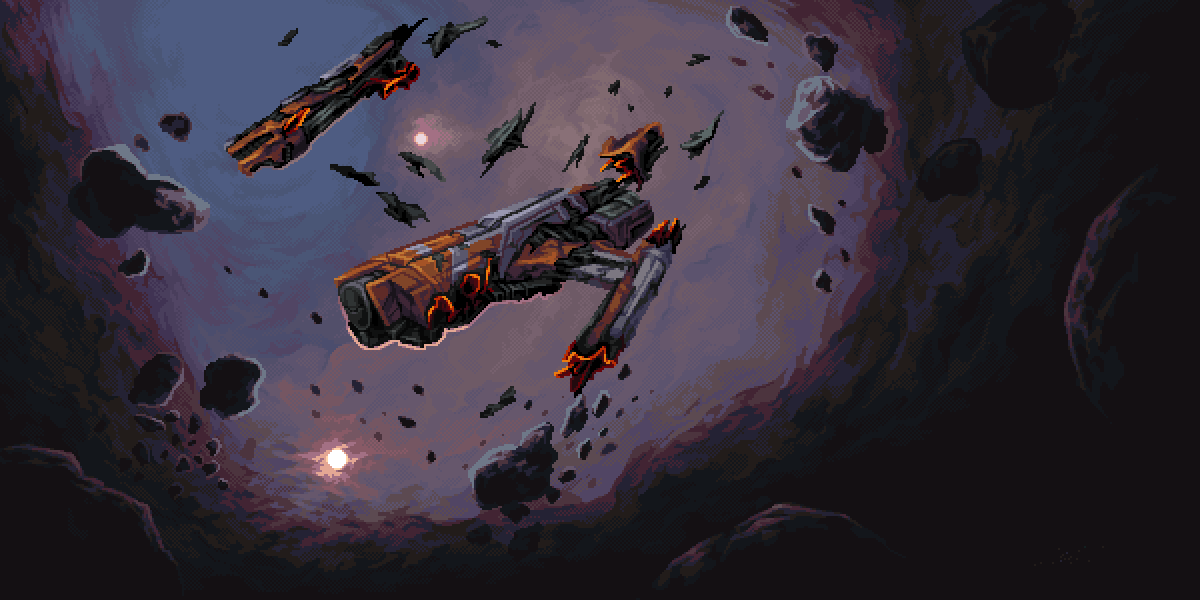
In order for the player’s actions in the world to matter, there need to be consequences, both positive and negative. The perception of having meaningful skin in game is more immersive than any VR headset. In The Citadel, we want there to be something at stake, something to fight for, and the means by which to fight. We envision a world driven by economic, political, and military conflict over scarce resources. The initial game loop centers around economic competition, but over time new forms of risk and rivalry will be introduced.
In a more abstract sense, there’s really two infinite games being played at the same time. The onchain world revolves around rivalrous PvP, but the game of owning, governing, and building the world is one of co-op co-creation. When a ship burns in the Abyss, the ship owner feels both the sting of loss in-world and the boon to the value of the ecosystem as a member of the DAO at the same time. It’s a zero sum game owned and operated by a positive sum community of players. We believe this greater experience can appeal to diverse interests and audiences.
While it’s quite possible these two games could clash with each other in all kinds of messy and interesting ways, we’re not sure one will work without the other. This is the design space we’re here to explore.
Architecting the World: Citadel Core
The Citadel is built on an open, modular core that can be infinitely and trustlessly expanded upon by community contributors. It will provide a unified framework and UI/UX for participating in the universe, including:
- The physics of the world
- Extensibility via expansion modules and permissionless building
- A default front-end and extensible client library
- Governance infrastructure and processes
- User generated content tooling and processes
Citadel Core represents the open, modular platform for collaboratively building this long term autonomous universe, while the governance framework outlines the social and coordination model that will steward it over the long term.

For Developers (DX)
Citadel Core will provide developers with:
- Onchain core service APIs as distinct modules
- Off-chain utility service APIs
- Public subgraph for fast queries
- Fast mirror for all images
- Official front-end, with distinct and individually usable data-source agnostic components
- Contributor tools
- Figma Design Files
- Pre-built and documented UI components
- Storybook for rapid prototyping
- A client library for game constants, lore, images, sugar over subgraph that can be used anywhere in off-chain apps
Community developers are empowered to independently contribute:
- Game modules
- Content expansion packs
- UI mods (official) and custom UIs
- Standalone apps
- Permissionless integrations and contributions
For Users (UX)
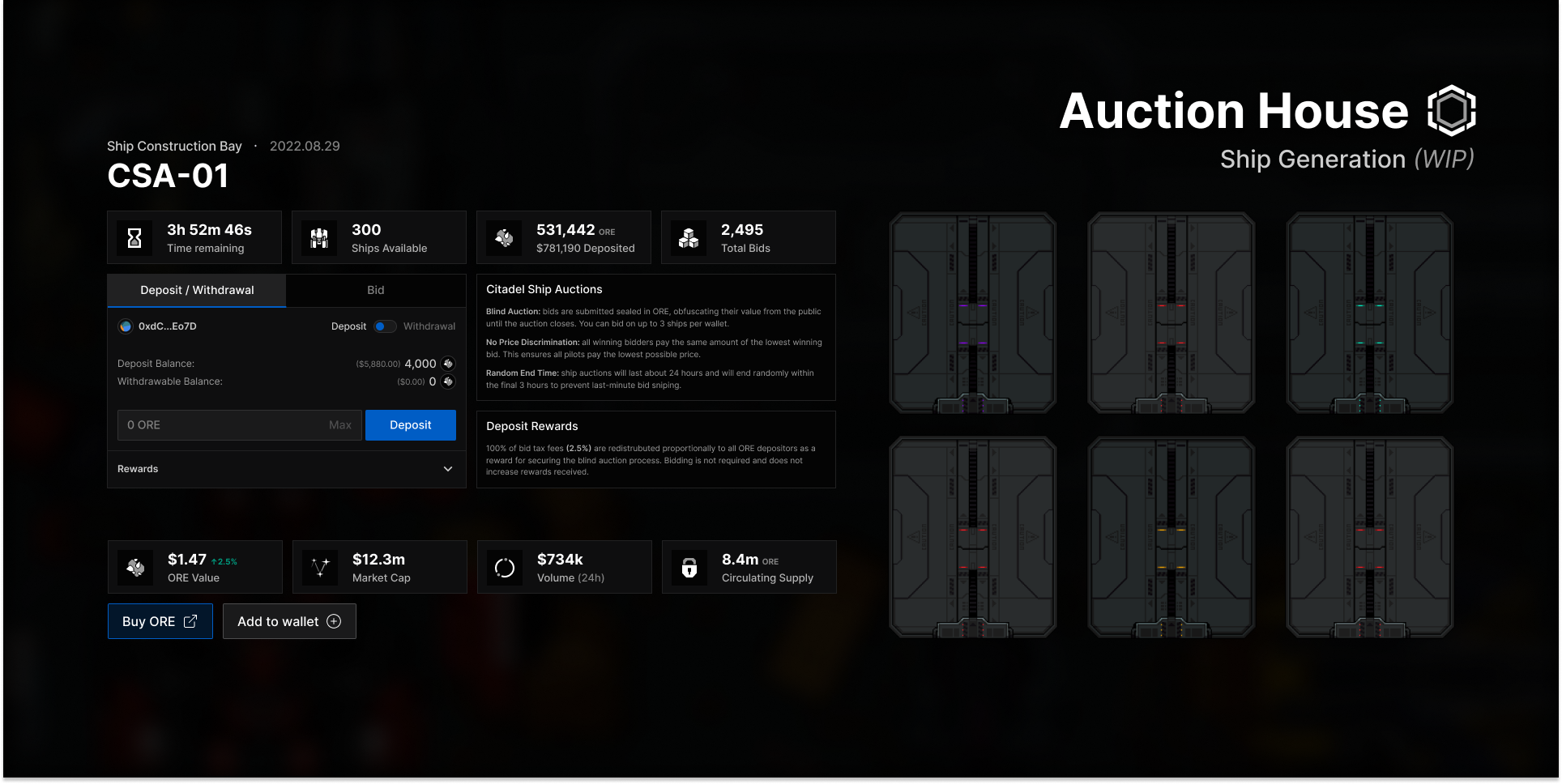
The Citadel provides unique views and features for a variety of ways to interact with the ecosystem.
Inhabiting the World
- The view into the game world itself and main interface.
- Many features of the platform are integrated directly into the game interface, others are separate apps. Over time, the goal is greater integration into an increasingly unified UI/UX.
Corporations and In-Game Governance
- Player corporations will act as a subDAO module for in-game governance of shared assets, territory control, and diplomacy.
- Corporations can eventually buy or capture large assets such as trade stations, warp gates, engineering complexes, resource refineries, navigation structures and collectively manage them via native subDAO governance mechanics.
- As more regions open up on the star map, there can be similar mechanics for the governance of entire regions, where things like local tax rates can be set.
Content Creators & Contributors
- Content creation, submission, and reviewing systems will empower any community member to submit individual pieces of content for review and possible inclusion in the universe:
- Lore crafting, world building, in-game narratives and quests
- Videos, articles, art, memes
- Game assets including art (e.g. ship skins), music, sound
- Modular assembly of objects from player crafted primitives
- Approved content contributions are rewarded at standard rates and may earn tokens, in-game items, and achievement rewards like XP, badges, and roles
- Initially, contribution will require more technical savvy and/or governance overhead, but over time the goal is to make contribution accessible to everyone
Proposal Governance
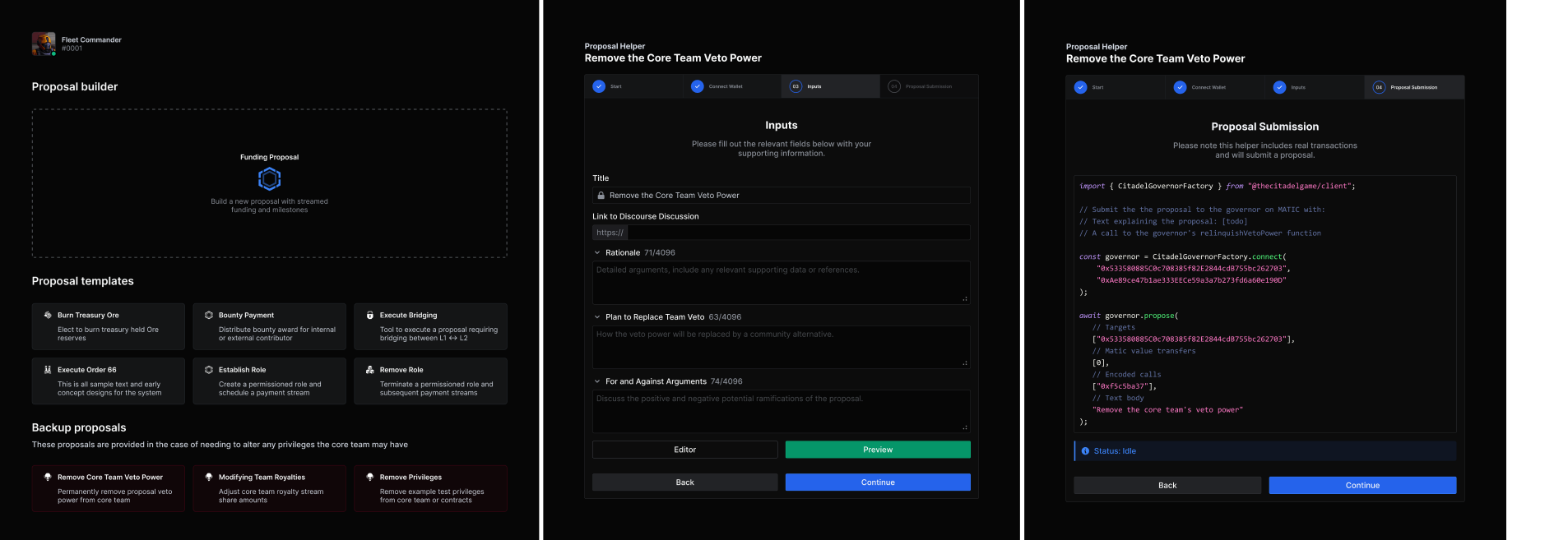
- A custom UI for our proposal governance system is tightly integrated into the OS.
- Hooks into reputation and achievement systems for gamifying and rewarding positive-sum participation in governance.
- Streamlined UI makes participating as accessible and enjoyable as possible.
Working Groups and other subDAOs
- A subDAO management interface that allows for easily spinning up and down working groups, corporations, in-game governments, and any other forms of subDAOs that are natively compatible with the rest of the ecosystem but are technically sovereign onchain entities.
Governance In and Over the World
Virtual worlds introduce a novel conundrum to matters of governance. The very fact that they are created by us means they very well can be changed (or forked) by us. Unlike the physical world whose making and physics are mysterious, immutable, and unforkable, created worlds have to grapple with the question of how to govern the world-making powers hitherto reserved to gods.
The question of how to address the inherent power of developer deities has been a perennial point of conflict in virtual communities going all the way back to MUDs at a minimum, and likely all the way to the dawn of multi-user computer systems. It may be that one of the better use cases for DAOs is to decentralize the god-like power that developers wield by default in virtual spaces.
In addition to governing this “realm of gods” at the protocol level, governance institutions will also emerge from within the game world itself. The players as they exist within the confines of the created universe are subject to its physics, and must come to some understanding about proper conduct and organization among themselves. This could look like regional governments that decide such matters as local tax rates, subDAOs that collectively own space stations and warp gates, or alliances of player corporations.
With all of these entities existing as crypto native primitives, the lines between the real and the virtual are bound to be blurred in all sorts of interesting ways.
Contribution as Games
The line between virtual and real isn’t the only paradoxical boundary that creating a world on the blockchain allows us to play with. When everything is composed of blockchain primitives, all sorts of interesting and novel opportunities to blend work and play arise.
One example might be an onchain quest system that allows for arbitrary rewards, objectives, and completion criteria. Onchain DAO bounty systems will have much to learn from onchain in-game quest engines, and vice versa; in onchain worlds, these distinctions may become increasingly arbitrary. This could eventually converge on a unified reward system that tracks task completion across the spectrum of work and play. This could bring us closer to work that feels like quests, and play that benefits from the sophistication of serious work.
Other ideas to explore include:
- Gamified, co-op lore and world building app that uses trustless mechanics to determine what is and isn’t canon
- Bringing governance and content creation interfaces into the world itself – the capacity to build and govern the world from within the world
- Prediction market betting on live proposals
Striking a Balance Between Adaptability and Neutrality
Among blockchain games, there seems to be two primary schools of thought when it comes to governance.
Maximize Adaptability
The first argues that while we may host some game assets on decentralized networks for provenance and tradability, the project itself cannot be decentralized and remain viable. For everything else, the traditional order must be maintained. Developers must retain the unrestrained power to change any aspect of the game at any time in order to keep the game fair, balanced, fun, and cohesive. This represents the incumbent approach to game development and has a strong track record. However, it is also what has enabled the current state of the gaming industry, and will struggle to take advantage of some of the most interesting opportunities of blockchain games.
Maximize Neutrality
The second school of thought comes from various corners of the burgeoning fully onchain game scene. It posits that we should remove developer control entirely from the equation and take advantage of the blockchain-native capability to create immutable rules that can theoretically remain valid forever. Being wholly incorruptible, immutable rules unlock an unprecedented level of confidence in the credible neutrality of online games. This confidence opens up all kinds of composability and interoperability potential between component-level pieces, similar to DeFi legos.
We see much promise in exploring this idea for many applications including real and proper games that have actual win conditions – an “everlasting game” is a very interesting and novel concept that could quickly emerge as a genuinely unique genre. But we’re not building a pure game, we’re building a world.
The Middle Way: Balance Adaptability with Neutrality
When it comes to building an onchain, everlasting persistent world, we think the best approach lies in striking a balance between adaptability and neutrality.
Worlds want to be big. A player-driven world depends on enough players to drive it. If there’s no ability to adapt and evolve intact without potentially fracturing the community via forking at every major juncture, a persistent world could struggle to remain relevant. At the same time, how the world adapts and evolves should at a minimum elicit some level of consent of the inhabitants of that world. Players should not be at the mercy of the whims of developer deities, and the world should be able to outlive its creator’s involvement.
The challenge and purpose of governance in The Citadel is in balancing the tension between effectively managing the operational complexity of persistent world development and live ops while maintaining sufficient decentralization to protect the best interests of the community and project for the long term. A concept we’re interested in exploring at the moment is an accountable representative decision making module paired with a bottom-up proposal governance and contributor pool system.

Elected Coordinators: Accountable Leadership and Stewardship
- Initially helmed by the Core Team
- Gathers and shares high level context between major ecosystem participants
- Initial maintainers of off-chain support systems and services
- Coordinates and integrates work streams from working groups, community teams + orgs, service providers, and individual contributors
- Initiates new game module, app, and content expansion pack projects alongside the contributor pool according to high-level priorities of ecosystem
- Accountable to players via elected representatives in The Council and proposal governance
- Eligibility for leadership roles unlocked via onchain reputation criteria
Contributor Pool: Bottom-Up, Multi-Threaded Community Contribution
- Individual content creators can trustlessly contribute content for both the game world and the community at large, eventually with dedicated UGC tooling and autonomous processes
- Community teams can submit proposals to receive grants for building game modules, apps, or content expansion packs of their own conception
- Any player can engage in proposal governance as proposer, voter, and partake in proposal discussions
- Players can delegate votes to non-players to decrease the barrier to entry for contribution
- Gamified onchain reputation system reward hooks will eventually incentivize participation in all aspects of governance and contribution
- Players retain a voice in all matters with the wide-ranging power of onchain proposal governance
Minimizing Permission to Participate
Minimizing the amount of permission required to participate and contribute to a protocol with as many moving parts as a decentralized virtual world will be important in maintaining operational coherence. While there will be a permissioned coordination layer to help fill in the gaps between trustless systems, the farther down we can move any particular decision or contribution on the spectrum of permission, the less operator overhead and risk we need to manage. The idea is to make participation as accessible to as many people as possible while reinforcing minimum standards of quality assurance and maintaining effective ops.
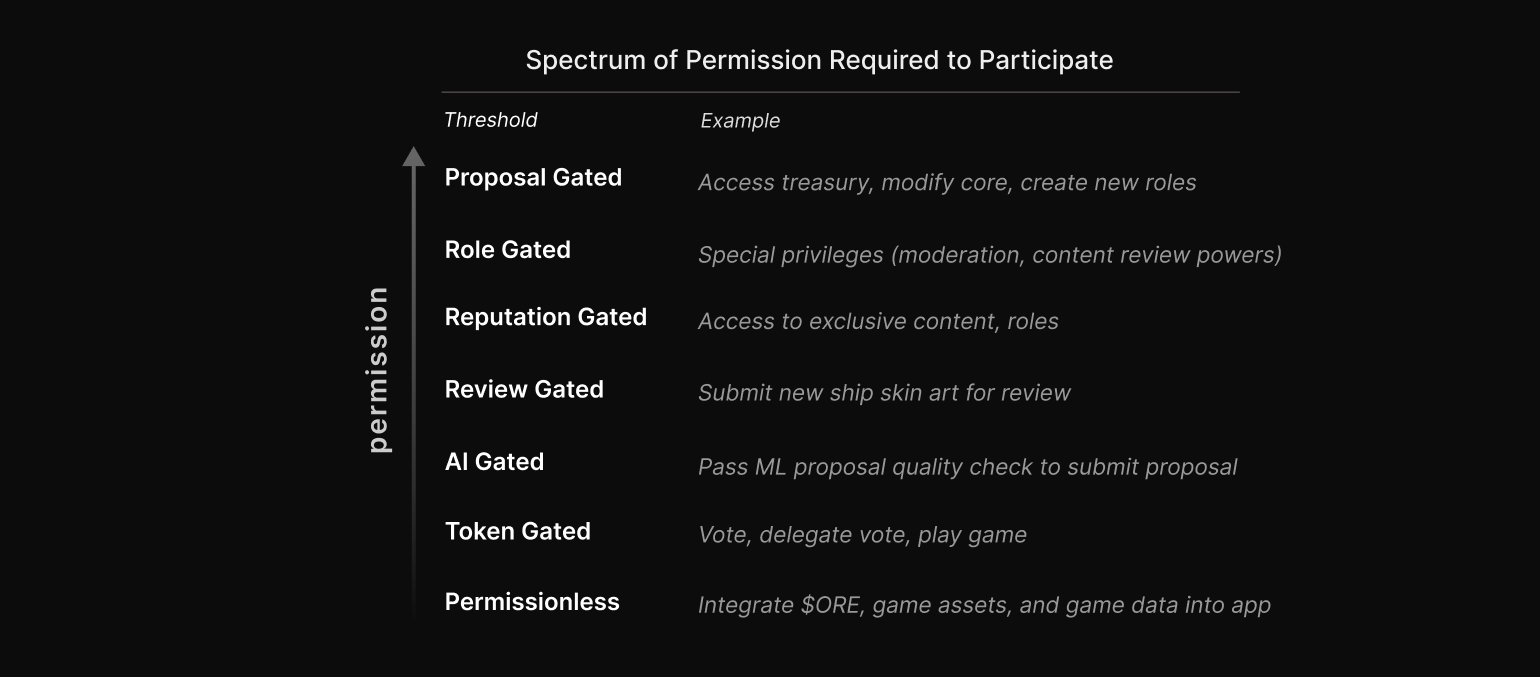
If we’re successful at this, we’ll make consistent progress toward aligning a diverse and wide ranging array of personalities, skill levels, commitment levels, and context levels toward the same vision.
Open Ended Tech Tree vs. Linear Roadmap
For collaborative, decentralized projects, we may need a new type of map. The standard roadmap is useful for charting a course over well trodden terrain towards a known destination. But when exploring uncharted territory with an open ended destination, a better map for our game may come from the game medium itself: the tech tree.
Tech trees, common in strategy games, are based on unlocks and connections. Rather than focusing solely on what a single item does for you in the moment, in a tech tree you’re always looking at what is unlocked in the future. What new paths are opened that were previously closed, and what is the total value of those opportunities? Tech trees allow us to look several steps down the path ahead and focus on the actions that unlock the most new opportunities to explore next.
In the multiplayer co-op game that is building The Citadel, tech trees allow multiple groups and individuals to walk parallel paths down separate areas of the tree at the same time. The deeper into the tree we project out, the more speculative the ideas get, but it’s fun to think about what becomes possible just a few unlocks into the tree.
Our tech tree might look something like the below:
Planned Expansions
While the platform is open to the emergence of what the community brings forth independently along any path of advancement, the Core Team does have a number of ideas we’re excited about contributing ourselves or supporting other builders on. While this is a living list and will change over time, it reflects the direction the team is heading in at the moment.
Post-Launch Priorities
- Ship cosmetics system with potential for submissions from community creators
- Rental bay for ship rentals
- Exploration ship class
- In-game marketplaces
- Region effects
- Governance UX upgrades
- SFX improvements
- GUI improvements
Additional Modules
- Solo or group based PvE and PvP combat encounters
- subDAO System
- Player corporations
- Player owned space stations
- Regional governance
- Territory control based PvP
- Gamifying governance, contribution, and community participation with an achievement + reputation system
Continuous Improvement Goals
- Radically improving and rethinking the UX of onchain interactions
- Reducing onboarding friction: the goal is for new players to “get it” within minutes of learning about the project while being guided down an intuitive path of entry
- Integrating governance, player corporations, and community participation into the greater game experience
- Providing more systems and processes to increase accessibility to community participation in the creative aspects of building out the game world
- Exploring more opportunities to take advantage of zero knowledge and machine learning tech for onchain applications
Final Thoughts
The Citadel was born out of the incredible experiences we’ve had in other worlds as well as all the ways those experiences were diminished by decisions we had no say over. We wanted to make the kind of world we wanted to experience ourselves. But we also believe we are still in the early era of not only blockchain gaming, but of virtual worlds as a unique medium.
Our motivation is not to merely port over the designs we already know how to build to the blockchain with minor tweaks, but to build a world that never could have existed without it. And ultimately, we believe much of this discovery will be the result of empowering passionate players we haven’t even met yet to create things we could never imagine.